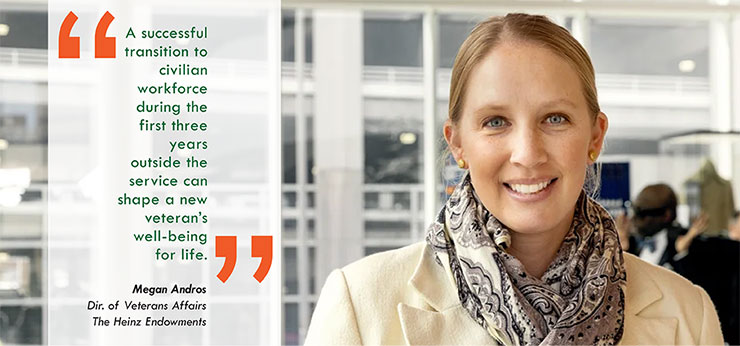

The Heinz Endowments workforce strategy aims to provide young adults with clear pathways to full employment, with a focus on "springboard careers" that offer advancement opportunities and family-sustaining wages. To achieve this, we seek to fund 501(c)(3) organizations that are:
The Endowments is a place-based philanthropic organization, but we welcome organizations headquartered outside of the southwestern Pennsylvania area to share ideas, as long as the services ultimately support job seekers in our 10-county region, which includes Allegheny, Armstrong, Beaver, Butler, Fayette, Greene, Indiana, Lawrence, Washington, and Westmoreland counties.
Would you like to connect with the Endowments about our workforce development initiative? Please contact us at: [email protected].
If your organization or program aligns with these strategic goals, please visit our grant applications page.
*MIT Livable Wage calculator for Allegheny County
We seek an evaluation and learning team to partner with The Heinz Endowments from mid-August 2025 to mid-August 2028. Given the recent launch of the strategy, this timeframe will focus on understanding what it takes to create pathways to meaningful, quality, full-time employment for young adults aged 16 to 24.
Deadline: Please submit to [email protected] by 5:00 pm ET on Monday, June 30.
The Heinz Endowments is entering a new phase in our education and training grantmaking that we believe will build upon and deepen the impact of our work. The Endowments has cared deeply about young people, supporting them from prenatal development and infancy to age 24 along with their families for decades and investing heavily in every life stage. Building on our experience and recognizing this unique time for our city and region, we will be focusing that commitment to take advantage of a significant opportunity to positively influence and help transform the workforce dynamic in the region. This evolution means targeting our attention and resources to create or enhance pathways that can lead to increased social and economic upward mobility for young people in southwestern Pennsylvania.
We believe this moment calls for our response because indicators are sobering: More than 5,000 students in the region leave high school every year having no graduation plan, job or direction for next steps.
The Endowments is energized about the opportunity to mobilize resources that can expand and accelerate efforts to steer youth and young adults in our region toward living-wage careers, especially those young people experiencing the greatest obstacles. The approach is also intended to address the perception that there is little to no opportunity for our youth and young adults to thrive in this region and that southwestern Pennsylvania lacks vitality and a bright future. We are challenging ourselves to work effectively and in partnership with many others so that the benefits of our investments will be significant.
We will be working to increase the proportion of residents ages 18 to 24 earning a living wage and making a pathway out of poverty. We will be supporting efforts to build a well-coordinated workforce infrastructure that supports career navigation by youth and young adults in southwestern Pennsylvania and contributes to a thriving community and regional economy. We will be striving to ensure that every person growing up in southwestern Pennsylvania sees a place and a future for themselves in the region and has the opportunity to choose a productive path in our economy and to flourish.
Over the past six months, members of our staff have worked with the Bridgespan Group, a consulting firm selected to support the planning process and assist us in developing a comprehensive, focused and measurable agenda. We are committed to transparency, and while the plan has not been finalized, we are far enough along in the process to have core information to share, which can be found in our strategy overview. This includes showing how the new investment approach builds on elements of our existing work and allows us to continue to expand certain critical aspects.
We recognize that this process of narrowing our investments is complex and will require changes in our grantmaking and a redirection within the portfolio in some areas. We will make every effort to be thoughtful and considerate about the changes.
The Heinz Endowments believes strongly that southwestern Pennsylvania’s more than 220,000 veterans — about 50,000 of whom have served in Iraq or Afghanistan — are huge and undervalued assets in our region, and their well-being and reintegration and that of their families are just one example of a national challenge that we are attempting to address.

The Endowment’s Program Director of Veterans Affairs, Megan Andros, who served in Operation Iraqi Freedom with the Army’s 1st Cavalry Division, penned this op-ed. Learn why now is a critical moment for federal attention to the estimated 200,000 servicemembers who transition from military-to-civilian workforce each year.
Our veterans deserve top-notch support when launching post-military careers, but a new Endowments-supported study reveals few programs and little federal support dedicated to helping them connect with civilian employers or apprenticeships that fully utilize their significant skills. There is limited evidence that the programs are effective, with some having no reported data, evaluation plans or outcome measures.
A new, first-of-its-kind study of veteran-serving, employment-focused nonprofits shows the essential role the nonprofit sector plays in supporting the 150,000 service members who reintegrate into civilian life each year.
The RAND report, funded by The Heinz Endowments, finds that service members seeking help in finding civilian jobs often turn to nonprofits due to a shortfall in assistance provided by the federal government. Despite their critical role, little is known about which nonprofit organizations and employment models are most effective in supporting veterans' employment in the civilian sector.


